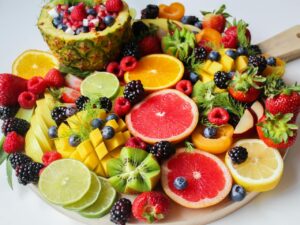Are fruits good for diabetes? Fruits and Diabetes: Finding a Balance
The connection between fruits and diabetes has long been a dance. The delicious sweetness of fruits filled with sugars may appear at odds with the carbohydrate restrictions needed for managing diabetes. Yet recent research offers a nuanced perspective highlighting the advantages of including fruits in a diet while considering some factors.
Navigating the Sugar Dilemma
Fruits are natural treats packed with nutrients, minerals, and dietary fiber. However, they also contain fructose, a sugar that can raise blood sugar levels. This raises concerns about whether fruits could worsen diabetes—a condition characterized by high blood sugar.
Promising News: Fruits and Diabetes Prevention
Enough recent studies have shed light on a twist. Consuming fruits is associated with a reduced risk of developing type 2 diabetes. Eating more fruit was associated with a 7% higher risk of type 2 diabetes, according to a meta-analysis that was published in the journal “Nutrients” in 2023.
This indicates that the health benefits of incorporating fruits into one’s diet outweigh any drawbacks—particularly when it comes to prevention.
The Essential Factor: Moderation and Selection
Nonetheless, moderation plays a role for individuals living with diabetes. Uncontrolled consumption of fruits can still lead to spikes in blood sugar levels.
When it comes to managing diabetes, it’s important to select fruits with an index. These fruits gradually release sugar into the blood. Incorporate choices such as citrus fruits, pears, apples, and berries.
Exciting news emerged with the 2023 Global Glycemic Index (GI) Update, which revised the GI values for fruits. For instance, grapefruit and grapes that were previously considered GI now have ratings. This updated understanding offers diabetics choices when navigating the fruit section with confidence.
The fiber content in fruits plays a role in their suitability for individuals with diabetes. Fiber helps slow down sugar absorption, preventing spikes in blood sugar levels. Berries, apples, and pears are very high-fiber fruits. Make decisions on behalf of diabetics.
Remember that fruits are not just about sugar. They are brimming with vital nutrients, vitamins, and minerals, as well as antioxidants, which are critical for maintaining general health and controlling diabetes. Fruits contain antioxidants that help reduce inflammation, which raises the possibility of diabetes-related problems.
To maintain harmony between fruit consumption and diabetes management:
1. Choose fruits: Opt for berries, apples, pears, citrus fruits, and plums.
2. Pay attention to portion control: Strive to include one to two servings of fruit in your diet. It’s always a good idea to consult with your doctor or dietitian for personalized advice. It is advantageous to eat fruits with protein or healthy fats, such as yogurt or almonds. This may aid in reducing how quickly sugar enters your body.
Additionally, it’s important to read food labels and check the sugar content per serving so that you can make choices. It is also recommended to listen to your body and monitor your blood sugar levels after consuming fruits, as this will help you understand how your body responds individually.
The relationship between fruits and diabetes is no longer seen as a melody; recent research shows that they can work together harmoniously, providing support in managing diabetes and promoting overall health. So go ahead. Embrace the variety of fruits available, but always take mindful steps and savor the sweet benefits of this balanced partnership.
Sweet Options for Sweet Lives: Navigating Fruits in a Diabetic Diet
Fruits for diabetic patients
Living with diabetes doesn’t mean sacrificing delicious fruits. While managing blood sugar remains crucial, a variety of fruits can be your healthy allies, bursting with vitamins, minerals, and fiber, all essential for good health. Let’s dive into the world of fruits for diabetics, exploring the latest research and tips for making informed choices!
The Balancing Act:
Fruits contain natural sugars, primarily fructose, affecting blood sugar levels. However, their glycemic index (GI) varies, indicating how quickly the body absorbs their sugars. Choosing fruits with low to moderate GI is key for diabetics. Remember, portion control is equally important – a serving is typically one small fruit or a cup of chopped fruit.
Latest News Highlights:
- Berries on the Rise: According to a recent study that was published in the Journal of Clinical Endocrinology & Metabolism, people with prediabetes who regularly ate blueberries had better blood sugar management and insulin sensitivity. Because berries are high in antioxidants and often have a low GI, they are excellent choices for those with diabetes.
- Melons Move Up: Watermelon, with its high water content and low GI, has long been a diabetic-friendly favorite. Now, research suggests that cantaloupe can also be a valuable inclusion, offering vitamins A and C alongside moderate fiber content.
- Guava Gains Ground: This tropical fruit is gaining popularity for its impressive vitamin C content and low GI. Studies indicate its potential to lower blood sugar levels and improve insulin sensitivity, making it a promising choice for diabetics.
Fruits to Embrace:
- Berries: Strawberries, blueberries, raspberries, and blackberries are low-GI powerhouses packed with antioxidants and fiber. Enjoy them fresh, frozen, or in smoothies.
- Citrus Fruits: Grapefruits, oranges, and tangerines are excellent sources of vitamin C and have a moderate GI. Enjoy them in moderation for a refreshing and nutritious boost.
- Apples and Pears: These classic fruits are low in GI and fiber, promoting satiety and helping regulate blood sugar. Opt for crisp varieties like Granny Smith for a satisfying crunch.
- Melons: Watermelon and cantaloupe are perfect summer treats, offering hydration and low GI sweetness. Enjoy them in wedges, cubes, or even blended into refreshing slushies.
- Guava: This tropical gem is gaining popularity for its potential blood-sugar-lowering properties. Enjoy it fresh, in salads, or as a delicious juice.
Fruits to Approach with Caution:
- Dried Fruits: While convenient, dried fruits are concentrated in sugar and calories. Opt for fresh or frozen fruits for a healthier choice.
- Tropical Fruits: Mango, pineapple, and bananas are delicious but have higher GI values. Enjoy them in moderation and pair them with protein or fiber to slow down sugar absorption.
- Fruit Juices: Juices often lack the fiber found in whole fruits, leading to faster sugar spikes. Stick to fresh fruits or unsweetened versions of pure fruit juices.
Sweet Tips for Success:
- Plan your fruit intake: Include fruits in your daily meal plan, considering their GI and sugar content.
- Pair fruits with protein or fiber: This helps slow down sugar absorption and stabilize blood sugar levels.
- Get creative: Try incorporating fruits into baked items, salads, smoothies, and homemade jams.
- Listen to your body: Pay attention to how different fruits affect your blood sugar levels and adjust your intake accordingly.
- Consult your doctor or a registered dietitian: They can personalize your fruit recommendations based on your individual needs and diabetes management plan.
Remember, living with diabetes doesn’t mean sacrificing the joyful world of fruits. With knowledge, smart choices, and a dash of creativity, you can embrace the sweetness of a healthy and delicious diabetic diet. So, reach for those vibrant berries, savor the crispness of an apple, and enjoy the refreshing burst of a watermelon slice – let fruits be your allies on your journey toward a healthy and fulfilling life!













+ There are no comments
Add yours